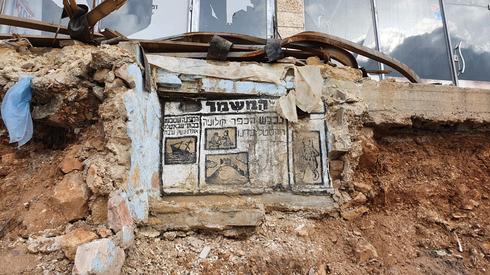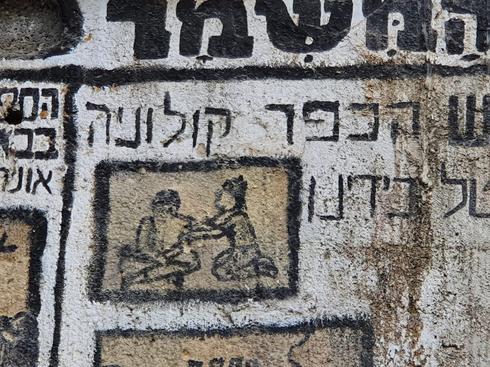A mural drawn by an Israeli soldier in 1948 during Israel’s War of Independence was uncovered recently, after a wall collapsed during construction work in Mevaseret Zion, near Jerusalem.
The 70-year-old painting was found on the remains of a house previously owned by Arabs, which was part of the village of Al-Qastal, captured by the IDF in April 1948 during operation ‘Nachshon’, and abandoned by its Arab population after heavy losses to both sides.
3 View gallery


The 70 year-old mural found in Mevaseret Etzion
(Photo: The Council for Conservation of Heritage Sites in Israel)
During the battle, Abd al-Qadr al-Husseini, leader of the Arab forces in the Jerusalem area, was killed, and the well-known Qastal Castle was conquered, it is now considered a populer heritage site.
On the remains of the house, a main road was paved and a commercial center was built. Construction work was carried out on the site, during which a stone fence collapsed to reveal the remains of the house and the mural.
The mural was drawn to resemble the front page of the "Al HaMishmar” newspaper, published in Israel between 1943 and 1995.
The murla’s headline reads: "The village of Qalunya was conquered; the Qastal is in our hands," alongside a painting of IDF forces climbing the castle fortress.
On the left side of the mural is a sinking ship with the title - "A ship sinking in Bari, Italy - an Arab weapons ship, along with a drawing an armed IDF soldier.
3 View gallery


The 70 year-old mural found in Mevaseret Etzion
(Photo: The Council for Conservation of Heritage Sites in Israel)
It seems the mural was painted by a soldier who participated in the battle for Al-Qastal between April 3-9, and later in the capture of the village of Qalunya located 6 kilometres (3.7 mi) west of Jerusalem.
The mural will be removed whole, and put into safe storage until Mevaseret Zion will finish building its Heritage Center, at which point the mural will be housed there permanently.
In the meantime, the Council for Conservation of Heritage Sites is looking for the soldier who painted the mural, or any of his unit members who could perhaps name the original artist.
3 View gallery


The 70 year-old mural found in Mevaseret Etzion
(Photo: The Council for Conservation of Heritage Sites in Israel)
“We assume the mural was painted by a soldier who was part of the battle of Al-Qastal and Qalunya,” said the Head of the Mevaseret Zion municipality, Yoram Shimon, “It is possible that the soldier served in the Palmach or the Etzioni Brigade that captured the castle and guarded it after a difficult battle.”
“The soldier painted the mural on an Arab house that was buried and destroyed.” added Shimon, “ we estimate the painting was buried for over 70 years ago. This is a very important historical finding. There are not many such findings in this area. We would love to find out who painted the painting, which if alive - should be around 90 today. "
Omri Shalmon, executive director of the Council for Conservation of Heritage Sites in Israel, said: “We consider preserving the legacy of the struggle for Israeli independence and its protection a very important value, and we will work together with the local council to rescue and preserve the discovery."

